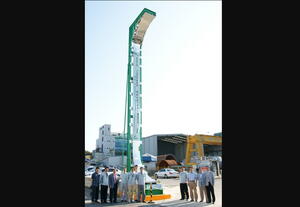A tall accomplishment
11 Feb 2011
-
Krista Dulon
12 metres high: the ITER Korea team stands before the full-scale mockup of the 10° vacuum vessel thermal shield inboard section, completed in 2010.
The Korean Domestic Agency, in cooperation with Daebong Acrotec, has completed a full-scale mockup of a 10° inboard section of the ITER thermal shield, and tested the main procedures of fabrication including cutting, bending, forming, buffing, welding, and machining.
"We are pleased to report that all the processes for thermal shield manufacture were demonstrated, with the exception of last-stage silver coating," said Wooho Chung, Technical Responsible Officer. "The fabrication of the mockup allowed us to validate the design and manufacturing process for the ITER thermal shield."
Inserted between toroidal field magnets and the vacuum vessel, the ITER thermal shield system minimizes the thermal radiation to the superconducting magnets. Made of stainless steel panels coated with low-emissivity silver, connecting joints (flanges) and cooling pipes welded to the panels, the thermal shield is operated within the range of 80-100 K during plasma operation. Its surface area covers 10,000 square metres; once assembled, it will stand 25 metres at its highest point.
Two thermal shield segments—the outboard segment and the inboard segment—will be manufactured separately by Korea and then assembled to form a full torus shape. As an open structure, each segment is susceptible to distortion caused by cutting, machining or welding. "It is very important to validate all design and requirement parameters before beginning fabrication," stresses Chung. "The tolerance requirements for the joints in particular are very strict."
During the fabrication of the 10° inboard section mockup, each step of the manufacturing process was validated. Panel thickness and distortion were measured after the bending and forming stages; all welds were successfully verified; and the machining processes were tested. One important finding from the mockup fabrication was that the inboard segment is more flexible than expected, making the handling jig essential during fabrication. However, the structural flexibility of individual segment is beneficial for the assembly of the 40° sector.
"We now plan to make another mockup—the thermal shield outboard 10° section—which will be assembled with the inboard section," says Chung. "These mockups will be used in the test of silver electroplating processes."
The detailed design of the ITER thermal shield will be reviewed in 2011. The beginning of fabrication is expected in early 2012.


